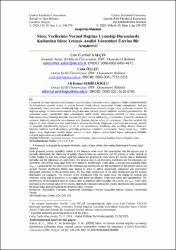Süreç Verilerinin Normal Dağılışa Uymadığı Durumlarda Kullanılan Süreç Yetenek Analizi Yöntemleri Üzerine Bir Araştırma
Özet
Literatürde ilk önerilmiş olan süreç yetenek indeksleri, süreç verilerinin normal dağılması, kalite karakteristiklerineait toleransların simetrik olması ve sürecin kontrol altında olması varsayımları altında çalışmaktadır. İlerleyençalışmalarda, süreç verilerinin normal dağıldığı ve toleransların asimetrik olduğu, süreç verilerinin asimetrik birdağılıma uyduğu ve toleransların simetrik olduğu durumlar için bazı yetenek indeksleri önerildiği görülmektedir. Buçalışmanın amacı, literatürdeki diğer çalışmalardan farklı olarak, toleransların asimetrik ve süreç verilerinindağılımının normal olmadığı durumlar için yeni bir süreç yetenek indeksi önermektir. Asimetrik toleranslı veasimetrik dağılımlı süreçlerin tanımlanması için Pearson dağılım ailesi ile çalışılmıştır. Önerilen indekste bazdağılım ile süreç dağılımının dört temel bileşeni karşılaştırılmaktadır. Dağılımın hedef değerden uzaklığı, basıklıkve çarpıklık değerlerindeki değişimi ile alt ve üst spesifikasyon limitlerine olan yakınlığı dikkate alınmıştır.Önerilen indeksin çeşitli durumlarda gösterdiği performans örneklerle incelenmiştir. Sonuç olarak indeksdeğeri, süreç dağılımının basıklık değeri arttıkça ve süreç dağılım verileri hedef değere yaklaştıkça artmakta,çarpıklık değerindeki artışlarda azalmaktadır. Early proposed process capability indices in the literature work under the assumptions that the process data is normally distributed, the tolerances of quality characteristics are symmetric and the process is under control. In further studies it's seen that various capability indices are proposed in cases where the process data is distributed normally and the tolerances are asymmetric, the process data is asymetrically distributed and the tolerances are symmetric. Aim of this study, apart from other studies in the literature, in this study, a new process capability index is proposed for the cases where the tolerances are asymmetric and the distribution of the process data is not normal. Pearson distribution family was studied in order to define asymmetric toleranced and asymmetric distributed processes. In the proposed index, the four main components of the base distribution and the process distribution are compared. The distance of the distribution from the target value, the change in kurtosis and skewness values and its proximity to the upper and lower specification limits were taken into consideration. The performance of the proposed index in various cases is examined with examples. As a result, the index value increased as the kurtosis value of the process distribution increased and as the process distribution data approached the target value, and decreased as the skewness value increased.
Kaynak
Çankırı Karatekin Üniversitesi İktisadi ve İdari Bilimler Fakültesi DergisiCilt
10Sayı
1Bağlantı
https://app.trdizin.gov.tr/makale/TkRVeE1qUTJOZz09https://hdl.handle.net/20.500.11857/2039
Koleksiyonlar
- Makale Koleksiyonu [443]
- TR-Dizin İndeksli Yayınlar Koleksiyonu [1037]



















